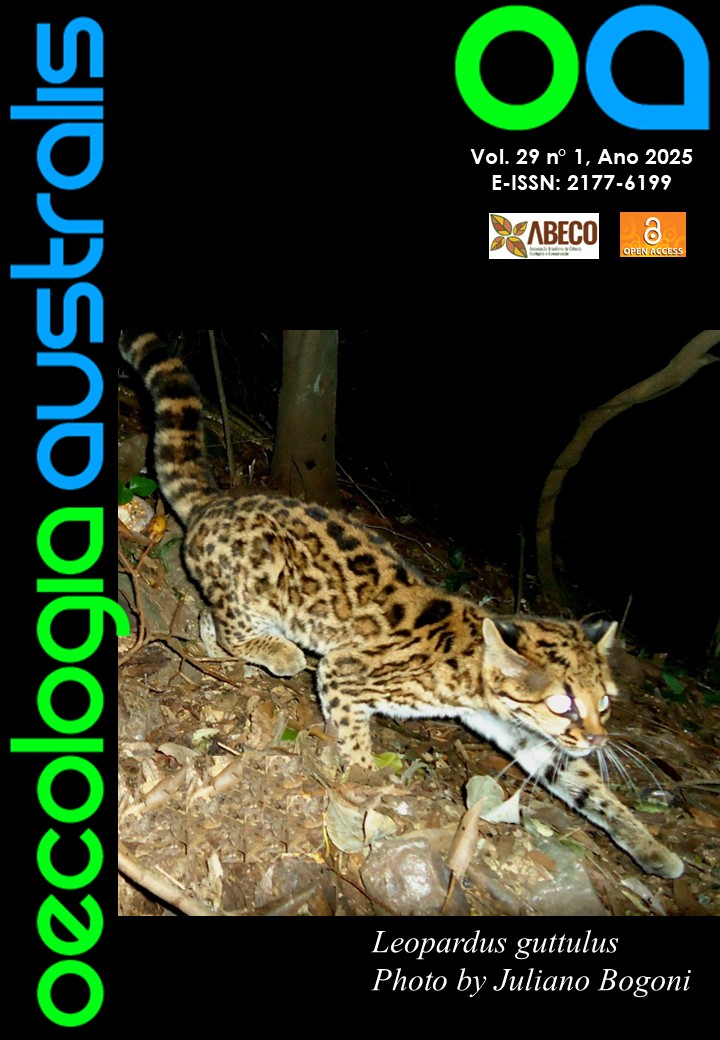DECISÕES METODOLÓGICAS ASSOCIADAS A LOCALIZAÇÃO DO NINHO E MODELO DE OVO AFETAM EXPERIMENTOS DE PREDAÇÃO DE OVOS ARTIFICIAIS DE AVES?
Efeito do local e tipo de ovo na predação de ninhos artificiais
DOI:
https://doi.org/10.4257/oeco.2025.2901.06Abstract
A predação de ninhos é o principal fator responsável pelo insucesso reprodutivo das aves. Através de um estudo experimental, investigamos como as decisões metodológicas associadas à localidade do ninho e ao modelo de ovo utilizado afetam a predação de ninhos artificiais. O experimento foi conduzido em 30 agroflorestas de cacau, localizadas no sul do estado da Bahia, nordeste do Brasil. Usamos 40 ninhos artificiais em cada agrofloresta, distribuídos de forma equitativa no solo e no sub-bosque, sendo 10 compostos por ovos sintéticos e 10 por ovos de codorna em cada estrato. Observamos que a predação foi significativamente maior em ninhos no solo (54,63%) do que no estrato superior (45,36%; p < 0,001). Também detectamos que ninhos compostos por ovos sintéticos apresentam 1,5 vezes mais chance (p = 0,04) de serem predados do que ninhos com ovos de codorna. Esses resultados podem estar diretamente associados à capacidade do predador em acessar os diferentes estratos da vegetação e predar ovos com diferentes texturas. Assim, recomendamos que estudos futuros considerem esses fatores metodológicos em seus delineamentos amostrais para evitar efeitos indesejáveis nos resultados.
CAN METHODOLOGICAL DECISIONS RELATED TO NEST LOCATION AND EGG TYPE AFFECT ARTIFICIAL EXPERIMENTS OF BIRD EGG PREDATION?
Nest predation is the primary factor responsible for the reproductive failure of birds. Through an experimental study, we investigated how methodological decisions related to nest location and egg type affect the predation of artificial nests. The experiment was conducted in 30 cocoa agroforests located in the southern Bahia state, in northeastern Brazil. We used 40 artificial nests in each agroforest, evenly distributed on the ground and in the understory, with 10 nests containing synthetic eggs and 10 nests containing quail eggs in each stratum. We observed that predation was significantly higher in ground nests (54.63%) than in the upper stratum (45.36%; p < 0.001). We also found that nests containing synthetic eggs had a 1.5 times greater chance of being preyed upon than nests with quail eggs (p = 0.04). These results may be directly linked to the predator’s ability to access different vegetation layers and prey on eggs with varying textures. Therefore, we recommend that future studies consider these methodological factors in their sampling designs to avoid undesirable effects on the results.


